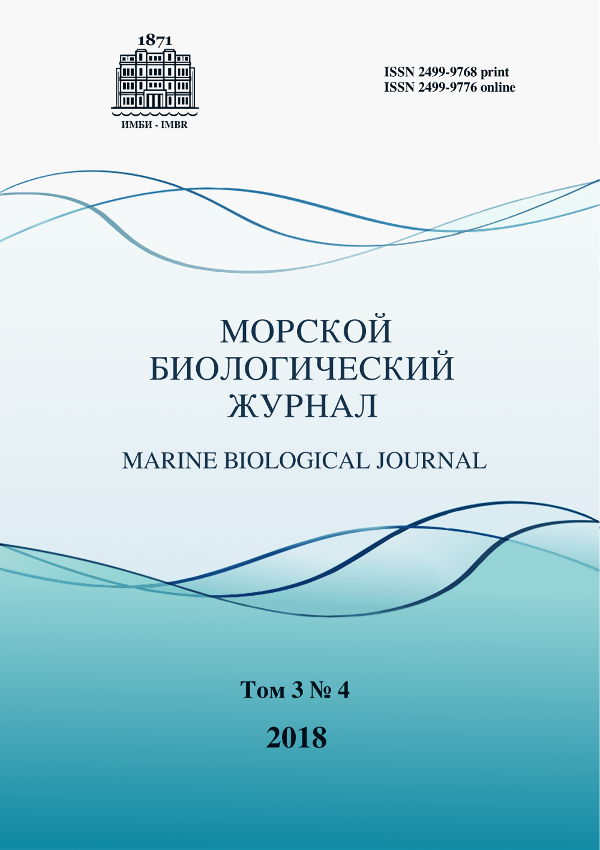Water turbulence effect on egg survival and characteristics of hatched larvae of the Black Sea turbot Scophthalmus maeoticus (Pallas, 1814)
##plugins.themes.ibsscustom.article.main##
##plugins.themes.ibsscustom.article.details##
Abstract
The impact of different level of turbulence on developing eggs and prelarvae of the Black Sea turbot Scophthalmus maeoticus obtained from the pair of wild spawners at the end of natural spawning season has been studied. The incubation was carried out at three different levels of turbulence generated by diffused aeration: without aeration (calm water), low aeration (34 ml per minute) and high aeration (75 ml per minute). In calm water hatching rate (HR) of turbot eggs was 20 % and the hatched prelarvae had the longest standard length (SL = 3.13 mm) and the biggest volume of the yolk sac (VYS = 0.37 mm³) as compared to those of low aeration (HR = 18 %; SL = 3.10 mm; VYS = 0.32 mm³) and high aeration conditions (HR = 14 %; SL = 3.10 mm; VYS = 0.29 mm³). One day after hatching the percentage of survived prelarvae from the number of hatched was the highest – 86 % at high aeration, compared with that of low aeration (72 %) and calm water (61 %). Application of turbulence leads to elimination of “poor” quality eggs during incubation, presumably enables hatching of more viable larvae and can reduce mortality of more advanced larvae.
Authors
References
Devauchelle N., Letty Y., Quere M. Experimental units for incubation and larval rearing with special reference to four marine fish species. Aquaculture, 1986, vol. 58, iss. 3–4, pp. 297–304. https://doi.org/10.1016/0044-8486(86)90095-5.
Gaignon J. L., Petton B., Quéméner L. Influence de l’hydrodynamique des bassins sur la survie et la croissance des larves de turbot (Psetta maxima). Bulletin Français de la Pêche et de la Pisciculture, 1998, no. 350–351, pp. 303–323. https://doi.org/10.1051/kmae:1998007.
Ignat’ev S. M., Mel’nikov V. V., Klimova T. N., Gubanov V. V., Biryukova M. A. Summer macro- and ichthyoplankton of Сrimea coastal areas in 2016. Sistemy kontrolya okruzhayushchei sredy, 2017, iss. 8 (28), pp. 93–100. (in Russ.).
Ivanov V. N. Voprosy tsitogenetiki kambaly-kalkana v svyazi s vozmozhnostyami ee iskusstvennogo razvedeniya. In: Biologicheskie osnovy morskoi akvakul’tury. Kiev : Naukova dumka, 1975, pp. 51–54. (in Russ.).
Klimova T. N., Ignat’ev S. M., Vdodovich I. V., Gubanov V. V. Sostoyanie ikhtio- i makroplanktonnogo kompleksov na shel’fe Krymskogo poluostrova v aprele 2016 g. In: Sistemy kontrolya okruzhayushchei sredy : mezhdunar. nauch.-tekhn. konf., 24–27 Oct., 2016. Sevastopol : IPTS, 2016, pp. 159. (in Russ.).
Mangino A. Jr, Watanabe W. O. Combined effects of turbulence and salinity on growth, survival, and whole‐body osmolality of larval southern flounder. Journal of the World Aquaculture Society, 2006, vol. 37, iss. 4, pp. 407–420. https://doi.org/10.1111/j.1749-7345.2006.00054.x.
Maslova O. N. Razvedenie i tovarnoe vyrashchivanie chernomorskoi kambaly-kalkana Scophthalmus maeoticus: problemy i metody. Trudy VNIRO, 2013, vol. 150, pp. 35–49. (in Russ.).
McEvoy L.-A. Ovulatory rhythms and over-ripening of eggs in cultivated turbot, Scophthalmus maximus L. Journal of Fish Biology, 1984, vol. 24, iss. 4, pp. 437–448. https://doi.org/10.1111/j.1095-8649.1984.tb04814.x.
Popova V. P. Osobennosti biologii razmnozheniya chernomorskoi kambaly-kalkana Scophthalmus maeoticus Pallas. Voprosy ikhtiologii, 1972, vol. 12, iss. 6, pp. 1057–1063. (in Russ.).


 Google Scholar
Google Scholar



